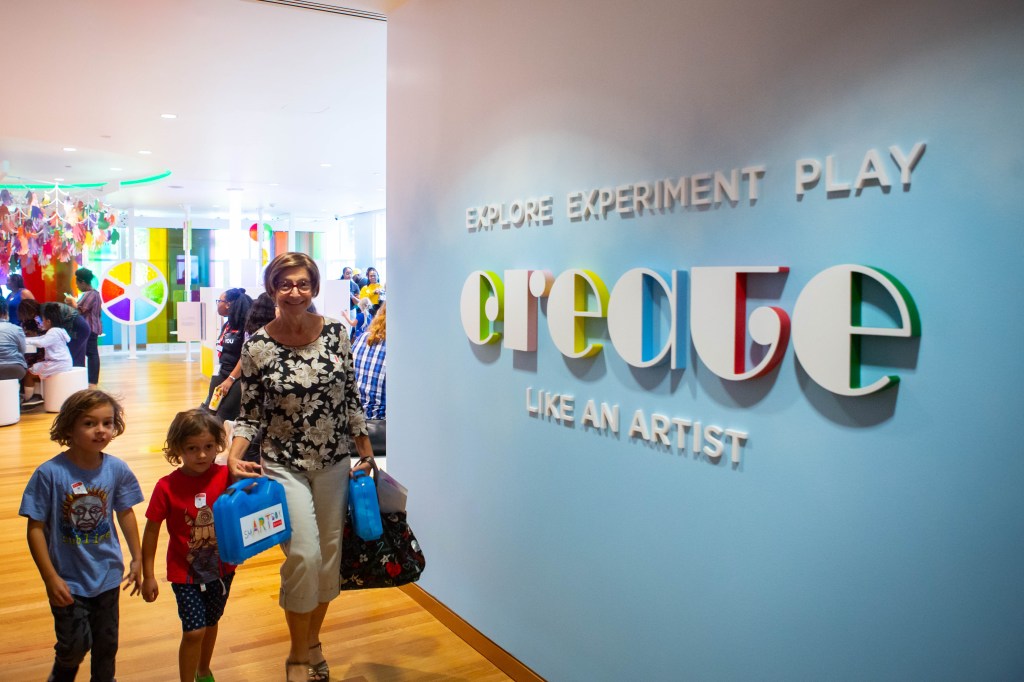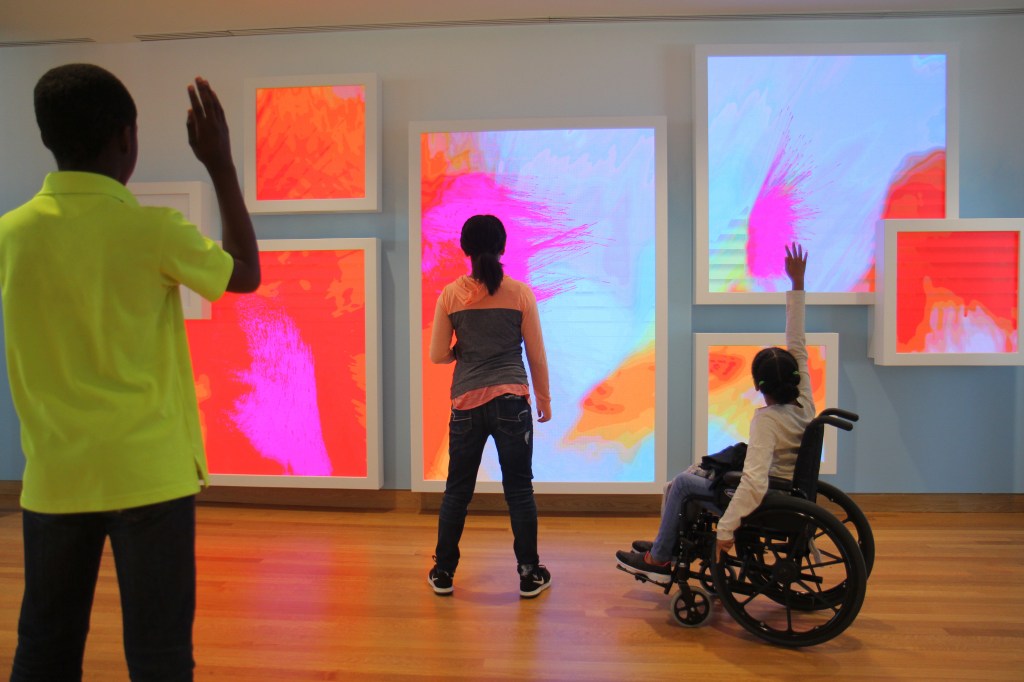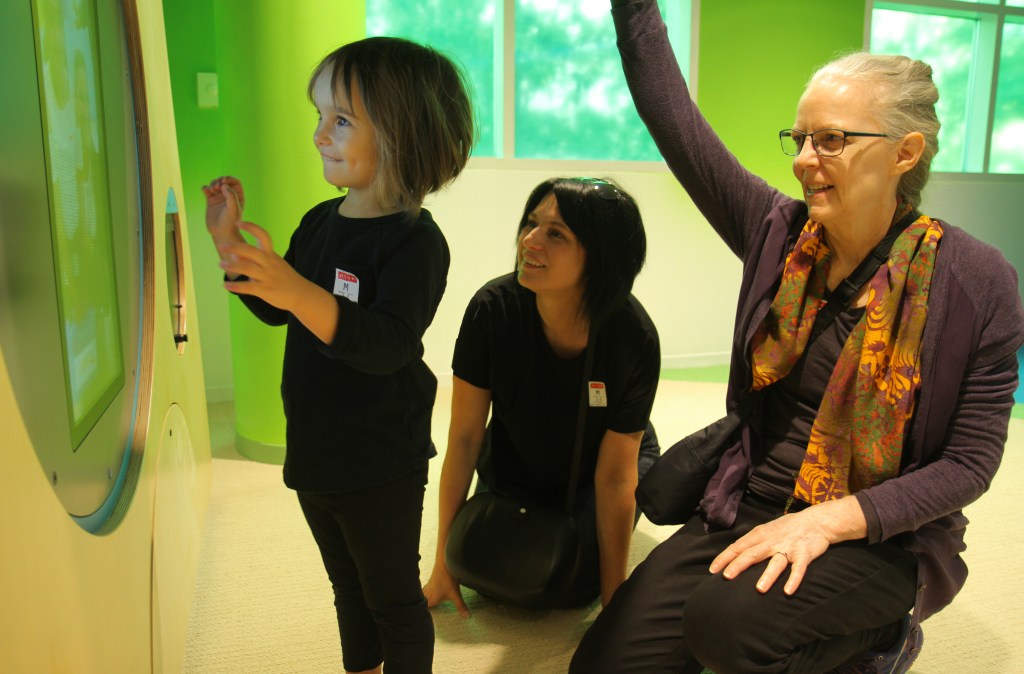
Cultivating a strong family audience is critical for museums, and as practitioners we use many different strategies to do this, including special family days and festivals, workshops, tours, backpacks, gallery guides, labels, in-gallery materials, audio tours, demonstration carts, and so on. But none of those approaches is a larger financial or spatial commitment than an interactive family gallery, a dedicated room or space where children can partake in developmentally appropriate hands-on activities. So why create one? Are they truly crucial to serving families and bolstering their wellbeing, or just a nice bonus?
Though this question is still debated today, dedicated educational and interactive spaces for families and children have a long history in our field. As Sharon Shaffer recaps in her wonderful book Object Lessons and Early Learning, in as early as the late 1880s museums like the Smithsonian were already to starting to cater to young visitors with specially set-aside spaces. At the High Museum of Art, our Junior Activities Center opened in 1968 with an installation called Color\Light\Color. The High’s director at the time, Gudmund Vigtel, called the space “my proudest accomplishment to date,” adding that “children are the art audiences of the future. The more knowledgeable they are, the greater the dialog possible between the community and the museum.”
Despite how long these spaces have existed, there has been little research in that time to validate their utility. We first realized this in 2005, when we presented at the Getty Museum symposium From Content to Play: Family-Oriented Interactive Spaces in Art and History Museums. As we listened to the presentations and talked with colleagues during breaks, we began to see there was a gap in the research on how families use and value such spaces, so we hatched an idea for a multi-year study across three art museums in the southeastern United States who had a strong track record of creating interactive spaces for families.
In 2007, we received a grant from the Institute for Museum and Library Services (IMLS) to conduct this research, partnering with two visitor research firms, Audience Focus and the Institute for Learning Innovation, on a four-year initiative called Family Learning in Interactive Galleries (FLING). Our overarching goal was to better understand how and in what ways interactive art museum experiences enhance family learning. We completed the study in 2011 and published the results online, then began to use this groundbreaking research in our practice, reinstalling our spaces and continuing our visitor evaluation. After a decade of refining our insights, we wrote a recently published book, Family Spaces in Art Museums: Creating Curiosity, Wonder, and Play, which takes our research and deep knowledge of best practices in creating interactive spaces and breaks it all down in a helpful “how-to” guide.
Skip over related stories to continue reading articleIn the process of completing the study and writing the book, we asked ourselves a few questions: How do families integrate their art museum experiences into their daily lives? How do those experiences support their learning agendas, family values, and family relationships? What motivates them to come, and what do they value about it? And what does that mean to us at the museum? This post provides a brief overview of the answers we’ve discovered.

For families with young children, interactive spaces provide a physically and psychologically safe place to explore and discover on their own in a sensory-rich environment that supports early learning development. In our research, some parents described the spaces as a kind of anchor in their museum visits. A majority said that without the interactive spaces they would not come to the museum as often or even at all. Almost 75 percent reported talking with someone about the benefits of their experience in the interactive space in the days or weeks following their visit, a powerful sign that the spaces make a difference.
Pro tip: When a museum has an interactive space, parents have more incentive to purchase family memberships.
Interactive galleries provide freedom for children—freedom to explore and engage in creative play, together or independently. Older or more self-directed children tend to choose their own activities. Families with one child tend to stay together in the interactive gallery, at least for part of the visit. Sometimes families engage in a type of “parallel play” with each family member doing their own thing but talking to each other and often showing each other their work.
Pro tip: This type of open-ended, creative play makes for repeat visitors.

A visit to a museum is not a solitary event that begins when the family enters through the door and ends when they exit. We have learned that parents often have post-visit discussions with their children on the trip back at home or during other family events. For example, families who frequently visit museums often discuss their visit over dinner or refer to it when engaged in a related activity later on. Families value the opportunity to make memories together, to bond as a group. To share a powerful example, a past president of the board of directors at the High Museum of Art shared that his first memory of the museum was playing in the family interactive installation The City (1974-1978), an experience which impacted the rest of his life.
Pro tip: A positive experience in an interactive space can turn a child into a future museum visitor—or even a patron.
We found out that parents went to great lengths to situate a family leisure learning experience within the larger context of the child’s life. They looked for opportunities to connect the art and interactive gallery activities with personal interests and the content of formal education lessons. Approximately 80 percent families in the FLING study tended to strengthen these connections at home through family discussions, as well as through engaging in artmaking activities inspired by their art museum and interactive gallery experience.
When we asked families to describe what they found valuable about their museum experience, they often referenced the fact that they enjoyed themselves and had a good time. We found that parents often assess the quality of their experience according to how much their children enjoy it. Some families commented that their experience in the interactive space led them to believe that “museums can be fun.” Museum staff sometimes express discomfort with this idea of “fun,” worrying that it distracts from a more serious educational experience. But if fun is what a family values most highly, isn’t that something we as practitioners should take to heart as we develop our interactive spaces?
Pro tip: Research strongly suggests we should change our attitude towards fun.

The museum experience, especially when supplemented with interactive galleries, gives parents a break, allowing them to put aside their teacher, facilitator, or guide role and enjoy being a member of the family group, because the teaching and guiding is already in place. As one parent put it: “I don’t have to prepare. It’s all there for me and I can enjoy being a mom and watch them learn as well as learn something new myself.”
Pro tip: Enjoyment also incorporates learning, and “edutainment” is not a bad word.
Our goal at the High Museum of Art is to make the museum an essential place for our community, where children and adults can engage together in informal learning and intergenerational communication and experience curiosity, wonder, and play. One of the truly exciting outcomes of the FLING study was that out of list of seven choices, parents ranked “feeling more positively about art museums” as one of the highest benefits that came from visiting the interactive space for themselves and their children. This is why our family interactive gallery is a key part of our long-term success in making the High essential.








Comments